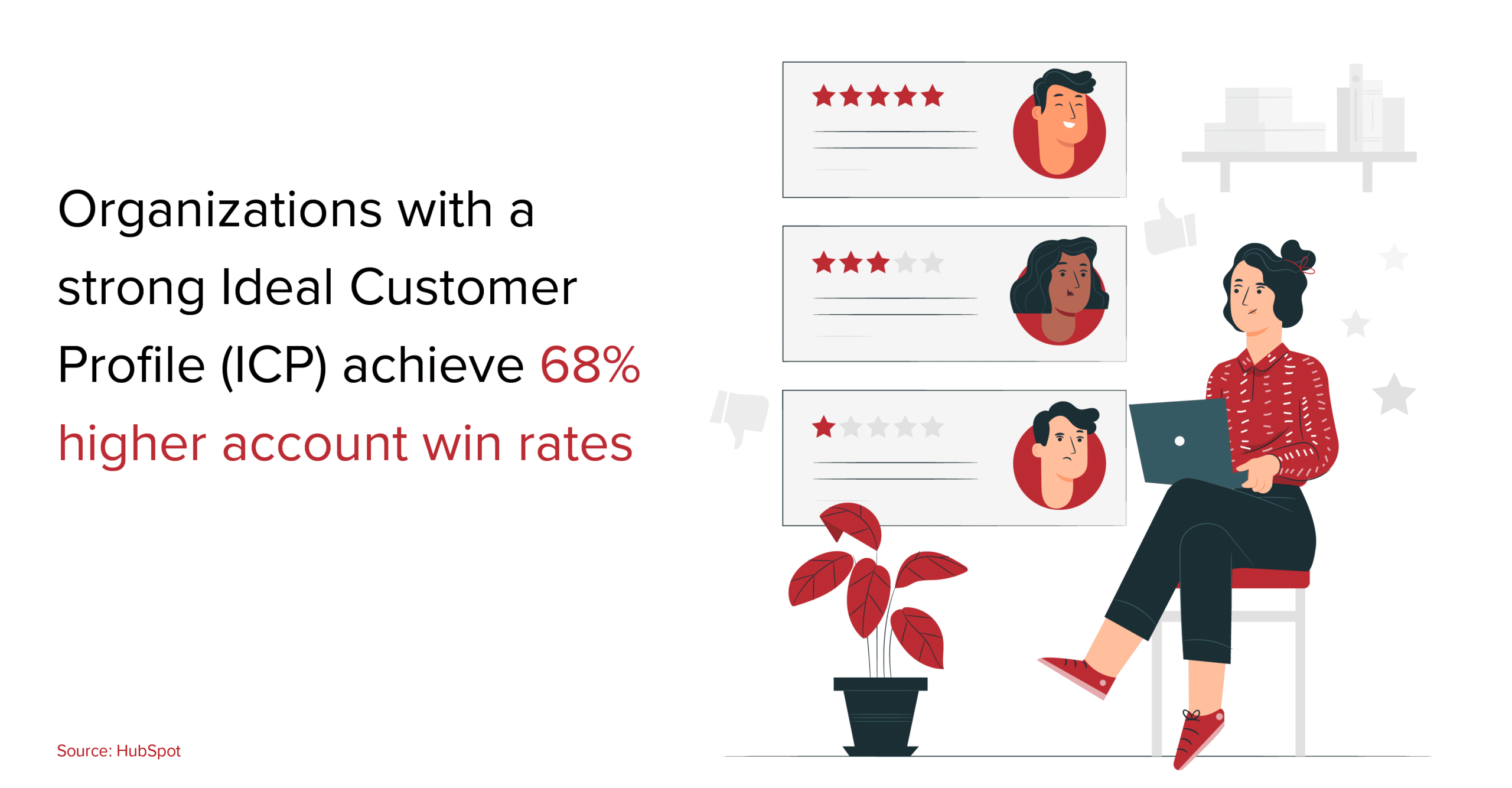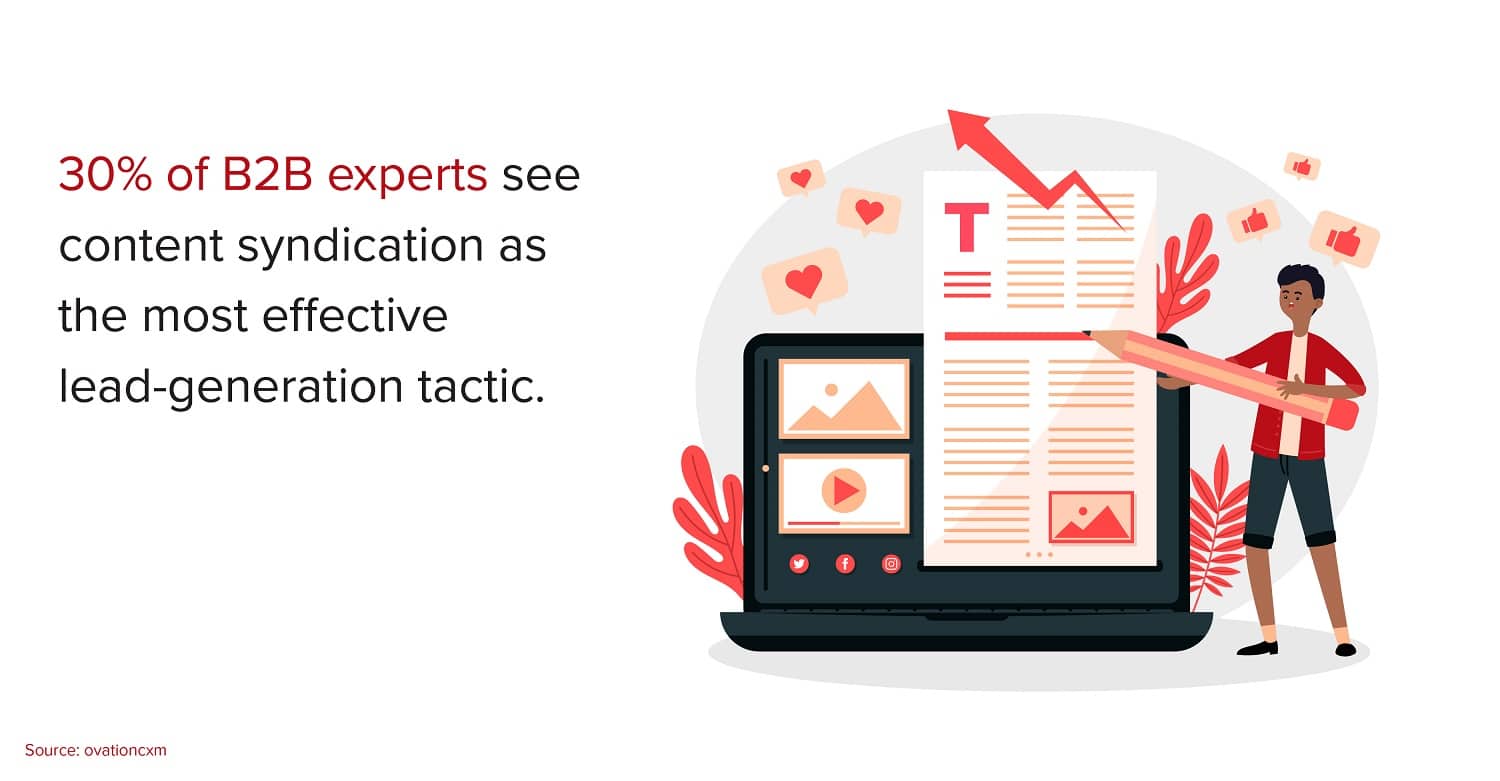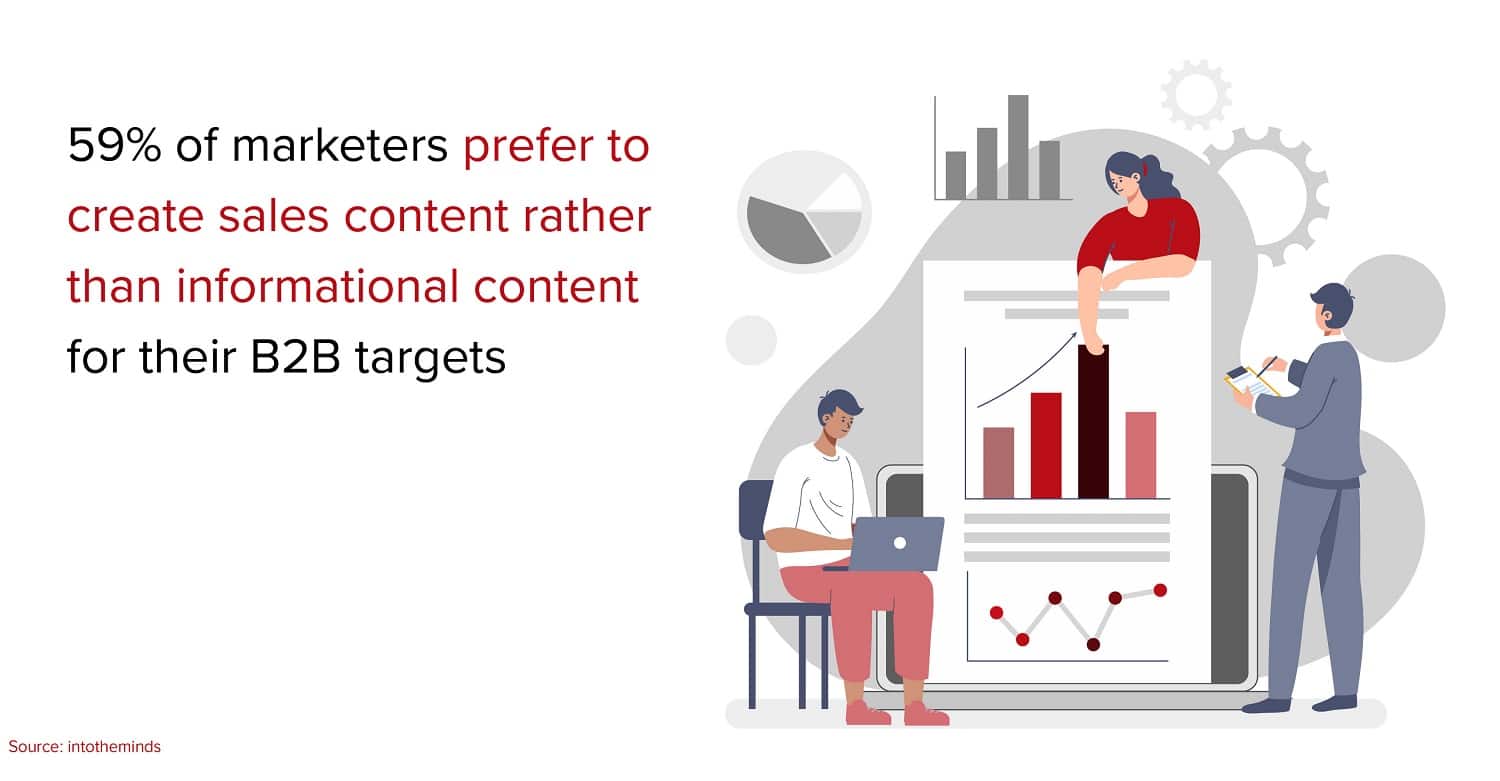In the modern internet era, where marketers have all the tools and technologies needed to empower them to create groundbreaking campaigns, there is no place for complacency. At least not in the B2B marketing space, if we have to be very specific. It has led to marketers constantly experimenting with new and innovative marketing strategies to generate leads and meet their business goals. Content syndication for B2B lead generation is one such effective marketing tool in the arsenal of modern marketers.
Businesses of all sizes leverage content syndication for marketing by creating and publishing unique and high-quality content across various digital touchpoints. Thus, it is only fair to talk about the benefits of content syndication as a marketing tool, the trends dominating the field of content syndication, and what the future holds for content syndication. So let us get started.
What is Content Syndication?
Content syndication refers to the process of distributing or republishing content from one source to multiple platforms or websites. It involves sharing your content, such as articles, blog posts, videos, or infographics on other platforms, reaching a wider audience beyond your website or blog.
It enables the sharing and distribution of content across multiple platforms to reach a larger audience. One of the prime benefits of content syndication is that businesses can increase their online visibility and reach more people with their high-quality content.
Simply put, content syndication is the process of republishing your content on other websites and networks to improve its discoverability. It’s a trade: the third-party website receives free relevant content, and your content is exposed to a new audience. This can help you earn backlinks to your website, which helps your SEO ranking and increases organic traffic. Moreover, it can add new leads to your pipeline and database. While theoretically it makes sense, but for content syndication to be a practical method of lead generation, you must consider at least three factors, which are:
- Only syndicate top-notch content: This is most probably the most significant tip. You don’t want to harm the reputation of your brand by posting poor content on other websites. Any content you syndicate should be highly customized, skillfully written, educational, and accurate.
- Curate where you syndicate: Not every website is made equally. Your brand will perform better on some websites than others. Before you begin syndicating your content, research the websites and the markets that would best suit your company.
- Promote both your original content and syndicated content: By doing this you can get the host website traffic’s attention. Include a link to the original version of the article on your website when you syndicate it. In addition to enabling site optimization, this will encourage people to visit your website again and give them the option to read the entire article if they’re interested.
Why use Content Syndication for B2B lead generation?
You must be thinking, my content is already generating traffic, why should I bother with content syndication? Sure, you already have top-notch content and get consistent traffic.
While this can be effective for nurturing, talking to your current list exclusively won’t help you find any new leads. This is where content syndication comes into play. By making your content available for resharing on other websites, you can generate leads through content syndication. It helps to raise your profile and increase traffic to your website, which generates more leads and boosts sales.
You essentially grant other websites permission to publish your articles on their websites when you syndicate your content. Usually, you receive a backlink to your website in return. This may improve search engine visibility and traffic to your website. It’s a win-win situation.
How to Implement an Effective B2B Content Syndication Strategy
Identifying the right target audience is half the battle won when it comes to lead generation. Thus, you must always make sure that the company you are considering for your lead generation and nurturing initiatives has enough experience in targeting and identifying the audience that is the right fit for your business. They should be able to carve an Ideal Customer Profile for your business and must be flexible enough to tweak their approach to accommodate your specific needs.
1. Define your goals
When using content syndication for growth marketing, you must start by defining your goals such as:
- What are you hoping to achieve?
- What kind of leads are you looking for?
- How many leads are you hoping to generate?
Once you understand your goals well, you can start planning your strategy.
2. Identify your ideal customer profile (ICP)
Your ICP should be as specific as possible. It should include factors like:
- What industry are they in?
- Where are they located?
- What is their designation?
- What size is their company?
- What are their pain points?
Once you’ve identified your Ideal Customer Profile, you can begin creating content for your target audience that will entice them to contact your sales executives. This will increase the likelihood that they will interact with your content and ultimately turn into customers.
3. Build a target accounts list
One of the best practices of content syndication is to create a list of target accounts. To do this, research your ideal client and narrow down their problems. Once you are aware of their problems, you can develop content that addresses those issues and syndicate it on relevant platforms. This will reach a larger audience of potential leads who are already interested in what you have to offer.
Assembling a target accounts list may appear daunting, but it is critical for any lead generation strategy. You can reach a larger audience and increase the number of leads for your company by investing the time to research your ideal client and produce targeted content.
4. Build the content asset
To maximize the number of leads generated by your content, syndicate it across as many channels as possible. This will reach a larger audience and increase the chances that someone will see your content and be interested in your product or service. Content syndication platforms can help you reach a larger audience by sharing your content across their websites and social media platforms, giving you the most exposure.
5. Promote the asset with CTA
Make sure to always include a call-to-action (CTA) when promoting your content. This could be as simple as asking readers to subscribe to your newsletter or share your content on social media or contact us. A key performance indicator for how well the content is received and used by its audience is the number of subscriptions. Including a CTA in your content while you syndicate helps viewers get in touch with you. Additionally, you can include contact information and a link to your website or landing page to ensure interested parties can reach you easily.
Content Syndication Best Practices
When executed correctly, content syndication can yield significant advantages. To ensure your content syndication efforts are effective, remember these important best practices:
- Implement Canonical Tags: Google suggests using canonical tags to indicate which version of your syndicated page should be featured in search results.
- Incorporate Backlinks: Each syndicated article should have a link leading back to the original piece. This not only boosts SEO but also directs valuable traffic back to your site.
- Spread the Word on social media: Once your content graces a third-party platform, share the link across your social media channels. It’s a fantastic way to draw in curious readers.
- Analyze Key Metrics: Keep tabs on crucial metrics, like referral traffic, to identify your syndication successes. This data will help refine your content syndication marketing strategy.
- Originality Matters: While syndicating, avoid duplicate content penalties by tweaking your pieces slightly for each platform. Google doesn’t like copycats!
- Credibility is Key: Partner with reputable platforms to maintain your content’s credibility. Avoid shady alleys; stick to the content main street.
- Clear Attribution: Ensure your content has proper attribution, linking back to your original masterpiece. Let people know where the real magic came from.
- Timing is Everything: Publish on third-party platforms after your original content has had some time to shine.
Current State of Content Syndication
With the advance of marketing technology and the growing penetration of data and analytics in the marketing space, the landscape of content syndication has grown significantly in recent years. This has resulted in an increased number of platforms and strategies to help content publishers reach a bigger audience and get more engagement.
The significant growth of social media platforms such as Facebook, Instagram, Twitter, LinkedIn etc., dominates the current state of content syndication. These platforms have emerged as the primary source for sharing and distributing content. It also has made it easier for businesses to reach out to their audience and engage with their followers.
Another noteworthy trend that is significantly gaining popularity in content syndication is the rise of content discovery and recommendation platforms. Platforms such as Taboola, Outbrain, and Revcontent have gained massive popularity among modern users. These platforms allow publishers to promote their content – often through paid promotion – to newer audiences who might not find their content otherwise.
Along with these third-party platforms, modern publishers are also trying new demand generation campaigns such as cross-promotion with other publishers or brands or collaboration with businesses of the exact nature of a collaborative content piece to reach their audiences.
Finally, the current landscape of content syndication with new platforms and newer strategies makes it essential for modern businesses and publishers looking to leverage it to grow their reach and audience. However, the future for content syndication looks equally exciting for modern marketers, and we will discuss why later in the post.
Popular Content Syndication Platforms
The growing number of content syndication platforms has made them a primary source for publishers looking to distribute their content and sometimes even monetize it.
Some Popular Content Syndication Platforms
Outbrain
A content discovery and recommendation platform, Outbrain allows publishers to syndicate their content on websites such as CNN, ESPN, and The Guardian and reach new audiences.
Disqus
Disqus is a prominent commenting system that allows content publishers to syndicate their content on relevant blogs and websites.
Taboola
Taboola is also a content recommendation platform which operates on a PPC model. It allows publishers to syndicate their content on premium websites such as USA Today, NBC, and The Weather Channel.
There are many other content syndication platforms that you can leverage based on the nature of your business and the campaign type.
Emerging Trends of Content Syndication
Content syndication is an ever-evolving space, and when the technology or the business landscape changes, content syndication strategies, benefits of content syndication, and campaigns change accordingly. As we look at the content syndication space, there are some noteworthy trends that a marketer must be aware of.
Here are some of them for you:
• Focus on Personalization
The customer growth-generated data has given business owners a lot of personal insights into their customers. All this information means businesses can emphasize the personalization of campaigns and offers for a better customer experience. One aspect is tailoring content specific to its customers’ likes and delivering it through the most relevant channels.
• Integration with AI and Machine Learning
AI-powered content syndication platforms are gaining massive popularity among businesses. Thanks to their incredible ability to analyze huge data sets to establish demand generation trends, improve performance, and optimize distribution. AI and machine learning can also personalize content to curate personalized customer experiences.
• Increased Use of Video and Interactive Content
Video and interactive content have emerged as preferred content for audiences. Publishers are now creating more video and interactive content and syndicating it through various platforms to gather maximum engagement. The growing popularity of short-form video platforms such as Instagram Reels, TikTok, and YouTube Shorts has further opened new avenues for publishers to try and experiment with new content formats and styles.
• Quality over Quantity
Content syndication has traditionally ribution of content. However, in recent times with the growing popularity of personalized content among customers, businesses have started to recognize the significance of quality over quantity. Businesses are now creating engaging, high-quality content that resonates with their target audience as opposed to just churning out huge chunks of content.
• Publisher and Brand Collaboration
With brands looking to create authentic and genuine content, they need publishers to showcase all that content. This is why we will continue to see the rise of brand and publisher collaboration. It will be a win-win for both.
Overall, going by the growing trends in the content syndication space, we can safely say that there is an increased emphasis on content quality, personalization, and collaboration, as the marketeers seek to engage with customers in new and innovative ways.
Benefits of Content Syndication
Content syndication provides benefits that extend beyond audience growth. The real value emerges from the possibility of engaging potential buyers among those vast number of new digital asset viewers. This underscores the importance of content syndication in lead generation—a vital aspect of targeted marketing that emphasizes quality over quantity.
10 Major benefits of content syndication
1. Increased exposure and reach
Content syndication allows you to distribute your content to various platforms, websites, and channels. This exposure extends your reach beyond your own website and social media profiles, helping you tap into new audiences that you might not have been able to reach otherwise.
2. Wider audience
By syndicating your content on platforms with different user bases, you can attract diverse audiences who may have different preferences and interests. This diversity can lead to increased engagement and the opportunity to connect with a broader range of potential customers or readers.
3. Enhanced SEO
When your content is syndicated, it often includes backlinks to your original content. These backlinks can positively impact your website’s search engine ranking, as search engines view backlinks as a sign of credibility and authority. As your content is shared across multiple websites, the likelihood of acquiring more quality backlinks increases.
4. Brand visibility and authority
As your content appears on reputable platforms, your brand gains visibility and establishes authority within your niche or industry. This can help position your brand as an expert and trustworthy source of information, which can lead to increased credibility among your target audience.
5. Cost and time efficiency
Content creation requires time, effort, and resources. Content syndication allows you to repurpose existing content, making the most of your efforts. Instead of creating entirely new content, you can adapt and share content you’ve already produced, saving time and resources.
6. Cross-promotion
Content syndication often involves partnerships with other publishers or platforms. This cross-promotion can introduce your brand to a new audience that trusts the platform you’re syndicating with, potentially leading to new followers, subscribers, or customers.
7. Improvement in lead generation
By reaching a wider audience through syndication, you have a higher chance of generating leads and conversions. A larger pool of potential customers means more opportunities to attract individuals who are interested in your products, services, or content.
8. Reinforcing brand message
Consistently syndicating relevant and high-quality content reinforces your brand’s messaging and values across multiple channels. This consistency can help solidify your brand image in the minds of consumers.
9. Adapting to different formats
Different platforms have different content preferences and formats. Syndicating your content across various channels allows you to adapt your content to different formats (such as video, audio, or written articles), appealing to a wider range of audiences with varying preferences.
10. Long-term impact
Syndicated content can have a lasting impact, as it remains accessible on various platforms over time. This can result in a continuous flow of new visitors, engagement, and potential leads, even long after the original content was created.
Predictions for the Future of Content Syndication
While predicting any trend in the volatile modern market is tough. However, going by the current landscape of content syndication driven by personalized, video, and interactive content, here are our predictions for the future of content syndication.
1. First-Party Data in Content Syndication
With a growing emphasis on first-party data, marketers and publishers will soon leverage it for their content syndication strategies.
2. Growth of Niche Content Syndication Platforms
Niche content syndication platforms are designed to cater to customers/audiences of a specific industry. They will become even more prevalent in the future by offering audiences incredibly targeted and relevant content.
3. More Focus on Metrics and Analytics
With the influx of data and analytics, content syndication will become more sophisticated. This will mean that the metrics and analytics will have an even more crucial role in determining the success of the campaigns and optimizing the strategies for content distribution.
To sum things up, in the future, we will see content syndication evolve into a highly advanced and sophisticated marketing strategy. Businesses will be keen to leverage it to engage with their targeted audiences in a progressive and technology-driven way and leverage the benefits of content syndication.
Conclusion
In summary, the future of content syndication looks exciting from every aspect, with plenty of advanced technological developments and a growing emphasis on high-quality, personalized content. While many modern businesses have already started adopting content syndication as an integral part of their marketing strategies, we will see that number go further up as businesses focus on niche content platforms, interactive/video content, and data analytics for optimizing and measuring the success of their campaigns.
Having said that, it’s worth mentioning that content syndication in no way is a one-size-fits-all solution. Thus, businesses must evaluate their goals, targeted customers/audiences, and even distribution channels while embarking on their content syndication journey. And if you are looking for experts to help you along the way, do write to us at: marketing@datamaticsbpm.com, and we will help you get started.
 Select an element to maximize. Press ESC to cancel.
Select an element to maximize. Press ESC to cancel.Frequently Asked Questions
In addition to intent-data and account-based marketing, content syndication is a powerful B2B lead generation strategy. To syndicate and publish high-quality content, big brands frequently work with publications. This helps them reach a wider audience and accelerates their growth marketing strategies.

Paul van de Kamp









